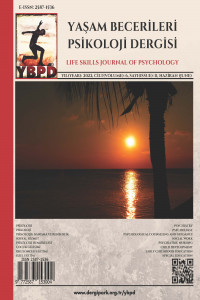Benlik Saygısının Akademik Motivasyon Üzerindeki Etkisi: Otomatik Düşüncenin Aracı Rolü
Bu araştırma benlik saygısı ile akademik motivasyon arasındaki ilişkide otomatik düşüncenin aracı rolünün incelenmesi amaçlanmıştır. Cinsiyet ve bölüm değişkenlerinin farklılığı ayrıca incelenmiştir. Kuzey Kıbrıstaki bir üniversitenin psikolojik danışma ve rehberlik ile zihin engelliler öğretmenliği bölümlerinden seçkisiz olarak atanan 210 lisans öğrenci katılımcı olarak çalışmaya dahil edilmiştir. Tüm katılımcılardan bilgilendirilmiş onam alınmıştır. Benlik saygısı için “Rosenberg Benlik Saygısı Ölçeği” kullanılmıştır. Buna ek olarak akademik motivasyonu ölçemk için “Akademik Motivasyon Ölçeği” ve otomatik düşünceyi belirlemek için de “Genişletilmiş Otomatik Düşünce Ölçeği” kullanılmıştır. İlişkisel tarama modelinin kullanıldığı bu çalışmada, aracı rolün etkisini belirlemek için Baron ve Knny’nin (1986) sundukları aracı rol analizi yapılmıştır. Benlik saygısı ile olumsuz otomatik düşünce arasındaki ilişkide motivasyonsuzluğun kısmi aracı rolü olduğu bulunmuştur. Toplam etki ve doğrudan etki puanları incelendiğinde %28 dolaylı etki olduğu belirlenmiştir. Motivasyonsuzluk, benlik saygısı ve olumsuz otomatik düşünce ile ilişkili olduğu gözlenmiştir.
Anahtar Kelimeler:
Akademik Motivasyon, Otomatik Düşünce, Üniversite Öğrencileri, Benlik Saygısı
The Effects of Self-Esteem on Academic Motivation: The Mediating Role of Automatic Thoughts
The purpose of the present study is to investigate the mediational role of automatic thoughts on the association between self-esteem and academic motivation. Differences would be analyzed separated according to gender and faculty studied. Participants of the study are 210 undergraduate students (%42.4, 89 women; %57.6, 121 men) selected randomly from counselling and intelligence teaching departments of University in Northern Cyprus. All permissions were taken. In order of the aim of self-esteem were assessed using ‘Rosenberg Self-Esteem Questionarie’’. In addition academic motivation was measured by ‘Academic Motivation Scale’ and ‘Automatic Thoughts Inventory’was used in measuring automatic thought levels of the participants. At this study relational screening analysis used, and mediation effect of automatic thoughts were analyzed using Baron and Kenny’s (1986) mediation analysis method. Partial mediation effect of amotivation subscale was proved among self-esteem and negative automatic thought. Evaluating the total effect and direct effect, it is indicated that, the difference is 28% of indirect effect value. Amotivation is related to self esteem and negative automatic thoughts
Keywords:
Academic Motivation, Automatic Thoughts, College Students, Self-esteem,
___
- Beck, J. (2014). Bilişsek Davranışçı Terapi: Temelleri ve Ötesi. Çev. Ed. Muzafer Şahin. Ankara:Nobel Akademik Yayıncılık.
- Beck, A. T. (1976). Cognitive Therapy and The Emotional Disorders. New York: Penguin Books USA Inc. 29.
- Beck, A. T., Freeman, A. ve Davis, D. D. (2004). Cognitive Therapy of Personality Disorders. Second Edition. New York: The Guilford Press. 31.
- Bozkurt, N. (1998). Lise öğrencilerinin okul başarısızlıklarının altında yatan, depresyonla ilişkili otomatik düşünme kalıpları. Yayınlanmamış Doktora Tezi. İzmir: Dokuz Eylül Üniversitesi Eğitim Bilimleri Anabilim Dalı.
- Corwyn, R. F. (2000). The factor structure of global selfesteem among adolescents and adults. Journal of Research in Personality, 34, 357–379.
- Çuhadaroglu, F. (1986). Ergenlerde benlik saygısı. Basılmamış Doktora Tezi. Ankara: Hacettepe Üniversitesi.
- Erden, M. (2008). Eğitim Psikolojisi. Ankara: Arkadaş Yayınevi.
- Di Giunta, L., Alessandri, G., Gerbino, M., Kanacri, P. L., Zuffiano, A., & Caprara, G. V. (2013). The determinants of scholastic achievement: The contribution of personality traits, self-esteem, and academic self-efficacy. Learning and individual Differences, 27, 102-108.
- Hiçdurmaz, D., İnci, F., & Karahan, S. (2017). Predictors of Mental Health Symptoms, Automatic Thoughts, and Self-Esteem Among University Students. Psychological Reports, 0033294117707945.
- Karagüven, M. H. (2012). Akademik motivasyon ölçeğinin Türkçeye adaptasyonu. Kuram ve Uygulamada Eğitim Bilimleri, 12(4), 2599-2620.
- Karahan, T. F., Sardoğan, M. E., Özkamalı, E., & Menteş, Ö. (2016). Lise öğrencilerinde sosyal yetkinlik beklentisi ve otomatik düşüncelerin, yaşanılan sosyal birim ve cinsiyet açısından incelenmesi. Türk Psikolojik Danışma ve Rehberlik Dergisi, 3(26), 35-45.
- Komarraju, M., & Dial, C. (2014). Academic identity, self-efficacy, and self-esteem predict self-determined motivation and goals. Learning and Individual Differences, 32, 1-8.
- Leeson, P., Ciarrochi, J., & Heaven, P. C. L. (2008). Cognitive ability, personality, and academic performance in adolescence. Personality and Individual Differences, 45, 630–635. http:// dx.doi.org/10.1016/j.paid.2008.07.00.
- McKinney, K. 2006. Encouraging Students' Intrinsic Motivation. Retrieved July 25, 2006, from http://www.cat.ilstu.edu/additional/tips/intMotiv.php
- Neel, C. G. O., & Fuligni, A. (2013). A longitudinal study of school belonging and academic motivation across high school. Child Development, 84(2), 678-692.
- Ryan, R.M. & Deci, E.L. (2000). Self-determination theory and the facilitation of intrinsic motivation, social development, and weel-being. American Psychologist, 55, 68-78.
- Topçu, S., & Leana-Taşcılar, M. Z. (2016). The role of motivation and self-esteem in the academic achievement of Turkish gifted students. Gifted Education International, 0261429416646192.
- Türkçapar, M. H. (2008). Bilişsel Terapi. Ankara: Hyb. Basım Yayın.
- Wolters, C. 2004. Advancing achievement goal theory: Using goal structure and goal orientation to predict students' motivation, cognition, and achievement. Journal of Educational Psychology, 96, 236-250.
- Warren, A. 2000. “OK, Retry, Abort? Factors Affecting the Motivation of Online Students”, ILT Web Based Learning Professional Development Day, University of East, Norwich, Anglia.
- ISSN: 2587-1536
- Başlangıç: 2017
- Yayıncı: Muhammed YILDIZ
